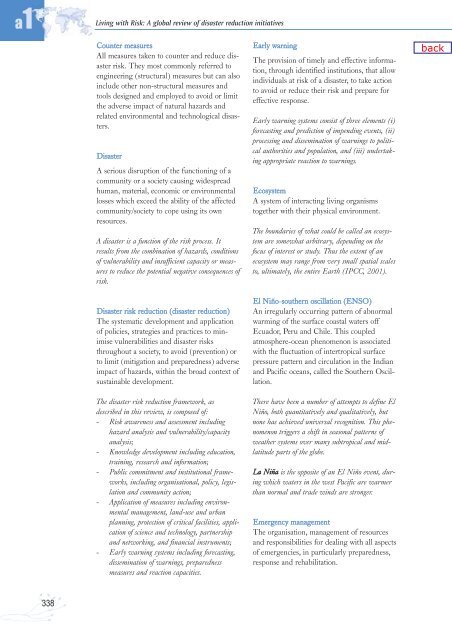Living with Risk. A global review of disaster reduction initiatives
Living with Risk. A global review of disaster reduction initiatives
Living with Risk. A global review of disaster reduction initiatives
Create successful ePaper yourself
Turn your PDF publications into a flip-book with our unique Google optimized e-Paper software.
a1<br />
<strong>Living</strong> <strong>with</strong> <strong>Risk</strong>: A <strong>global</strong> <strong>review</strong> <strong>of</strong> <strong>disaster</strong> <strong>reduction</strong> <strong>initiatives</strong><br />
Counter measures<br />
All measures taken to counter and reduce <strong>disaster</strong><br />
risk. They most commonly referred to<br />
engineering (structural) measures but can also<br />
include other non-structural measures and<br />
tools designed and employed to avoid or limit<br />
the adverse impact <strong>of</strong> natural hazards and<br />
related environmental and technological <strong>disaster</strong>s.<br />
Disaster<br />
A serious disruption <strong>of</strong> the functioning <strong>of</strong> a<br />
community or a society causing widespread<br />
human, material, economic or environmental<br />
losses which exceed the ability <strong>of</strong> the affected<br />
community/society to cope using its own<br />
resources.<br />
A <strong>disaster</strong> is a function <strong>of</strong> the risk process. It<br />
results from the combination <strong>of</strong> hazards, conditions<br />
<strong>of</strong> vulnerability and insufficient capacity or measures<br />
to reduce the potential negative consequences <strong>of</strong><br />
risk.<br />
Early warning<br />
The provision <strong>of</strong> timely and effective information,<br />
through identified institutions, that allow<br />
individuals at risk <strong>of</strong> a <strong>disaster</strong>, to take action<br />
to avoid or reduce their risk and prepare for<br />
effective response.<br />
Early warning systems consist <strong>of</strong> three elements (i)<br />
forecasting and prediction <strong>of</strong> impending events, (ii)<br />
processing and dissemination <strong>of</strong> warnings to political<br />
authorities and population, and (iii) undertaking<br />
appropriate reaction to warnings.<br />
Ecosystem<br />
A system <strong>of</strong> interacting living organisms<br />
together <strong>with</strong> their physical environment.<br />
The boundaries <strong>of</strong> what could be called an ecosystem<br />
are somewhat arbitrary, depending on the<br />
focus <strong>of</strong> interest or study. Thus the extent <strong>of</strong> an<br />
ecosystem may range from very small spatial scales<br />
to, ultimately, the entire Earth (IPCC, 2001).<br />
Disaster risk <strong>reduction</strong> (<strong>disaster</strong> <strong>reduction</strong>)<br />
The systematic development and application<br />
<strong>of</strong> policies, strategies and practices to minimise<br />
vulnerabilities and <strong>disaster</strong> risks<br />
throughout a society, to avoid (prevention) or<br />
to limit (mitigation and preparedness) adverse<br />
impact <strong>of</strong> hazards, <strong>with</strong>in the broad context <strong>of</strong><br />
sustainable development.<br />
The <strong>disaster</strong> risk <strong>reduction</strong> framework, as<br />
described in this <strong>review</strong>, is composed <strong>of</strong>:<br />
- <strong>Risk</strong> awareness and assessment including<br />
hazard analysis and vulnerability/capacity<br />
analysis;<br />
- Knowledge development including education,<br />
training, research and information;<br />
- Public commitment and institutional frameworks,<br />
including organisational, policy, legislation<br />
and community action;<br />
- Application <strong>of</strong> measures including environmental<br />
management, land-use and urban<br />
planning, protection <strong>of</strong> critical facilities, application<br />
<strong>of</strong> science and technology, partnership<br />
and networking, and financial instruments;<br />
- Early warning systems including forecasting,<br />
dissemination <strong>of</strong> warnings, preparedness<br />
measures and reaction capacities.<br />
El Niño-southern oscillation (ENSO)<br />
An irregularly occurring pattern <strong>of</strong> abnormal<br />
warming <strong>of</strong> the surface coastal waters <strong>of</strong>f<br />
Ecuador, Peru and Chile. This coupled<br />
atmosphere-ocean phenomenon is associated<br />
<strong>with</strong> the fluctuation <strong>of</strong> intertropical surface<br />
pressure pattern and circulation in the Indian<br />
and Pacific oceans, called the Southern Oscillation.<br />
There have been a number <strong>of</strong> attempts to define El<br />
Niño, both quantitatively and qualitatively, but<br />
none has achieved universal recognition. This phenomenon<br />
triggers a shift in seasonal patterns <strong>of</strong><br />
weather systems over many subtropical and midlatitude<br />
parts <strong>of</strong> the globe.<br />
La Niña is the opposite <strong>of</strong> an El Niño event, during<br />
which waters in the west Pacific are warmer<br />
than normal and trade winds are stronger.<br />
Emergency management<br />
The organisation, management <strong>of</strong> resources<br />
and responsibilities for dealing <strong>with</strong> all aspects<br />
<strong>of</strong> emergencies, in particularly preparedness,<br />
response and rehabilitation.<br />
338

















